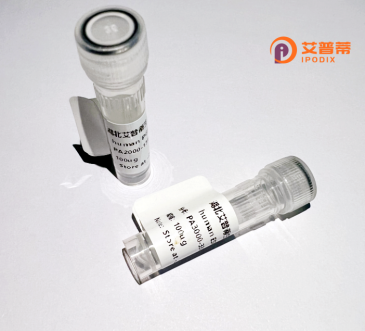
| 纯度 | >90%SDS-PAGE. |
| 种属 | Human |
| 靶点 | LGALS12 |
| Uniprot No | Q96DT0 |
| 内毒素 | < 0.01EU/μg |
| 表达宿主 | E.coli |
| 表达区间 | 1-366aa |
| 活性数据 | MSQPSGGRAPGTRIYSWSCPTVMSPGEKLDPIPDSFILQPPVFHPVVPYVTTIFGGLHAGKMVMLQGVVPLDAHRFQVDFQCGCSLCPRPDIAFHFNPRFHTTKPHVICNTLHGGRWQREARWPHLALRRGSSFLILFLFGNEEVKVSVNGQHFLHFRYRLPLSHVDTLGIFGDILVEAVGFLNINPFVEGSREYPAGHPFLLMSPRLEVPCSHALPQGLSPGQVIIVRGLVLQEPKHFTVSLRDQAAHAPVTLRASFADRTLAWISRWGQKKLISAPFLFYPQRFFEVLLLFQEGGLKLALNGQGLGATSMNQQALEQLRELRISGSVQLYCVHS |
| 分子量 | 62.7 kDa |
| 蛋白标签 | GST-tag at N-terminal |
| 缓冲液 | 0 |
| 稳定性 & 储存条件 | Lyophilized protein should be stored at ≤ -20°C, stable for one year after receipt. Reconstituted protein solution can be stored at 2-8°C for 2-7 days. Aliquots of reconstituted samples are stable at ≤ -20°C for 3 months. |
| 复溶 | Always centrifuge tubes before opening.Do not mix by vortex or pipetting. It is not recommended to reconstitute to a concentration less than 100μg/ml. Dissolve the lyophilized protein in distilled water. Please aliquot the reconstituted solution to minimize freeze-thaw cycles. |
以下是关于重组人LGALS12蛋白的3篇代表性文献概要:
---
1. **文献名称**:*LGALS12 regulates adipose tissue inflammation and metabolic dysfunction in obesity*
**作者**:Li, Y. et al. (2019)
**摘要**:研究揭示重组人LGALS12蛋白在肥胖模型中促进脂肪组织巨噬细胞极化,加剧炎症反应,并通过调控PPARγ通路影响胰岛素敏感性,提示其与代谢综合征的关联。
---
2. **文献名称**:*Recombinant human galectin-12 (LGALS12) induces adipocyte differentiation through lipophagy*
**作者**:Sun, Q. et al. (2017)
**摘要**:该文报道利用重组LGALS12蛋白激活自噬相关通路,促进前脂肪细胞分化为成熟脂肪细胞,并证实其通过脂噬(lipophagy)机制调控脂滴代谢,为脂肪生成研究提供新靶点。
---
3. **文献名称**:*Structural and functional characterization of recombinant human galectin-12*
**作者**:Zhang, H. et al. (2020)
**摘要**:通过大肠杆菌系统成功表达并纯化重组人LGALS12蛋白,解析其晶体结构,发现其碳水化合物结合域的关键残基,并验证其在细胞粘附和凋亡调控中的生物学功能。
---
这些研究涵盖LGALS12在代谢疾病、脂肪分化及蛋白结构功能等领域的机制和应用。如需具体文献来源,可进一步检索PubMed或SciHub获取全文。
Recombinant human LGALS12 protein, also known as galectin-12. is a member of the galectin family characterized by its affinity for β-galactoside-containing glycans. Encoded by the *LGALS12* gene, this 35-40 kDa protein contains a conserved carbohydrate recognition domain (CRD) crucial for ligand binding. Unlike many galectins, LGALS12 primarily localizes intracellularly, particularly in adipocytes and immune cells, and plays dual roles in metabolic regulation and cellular stress responses. Studies highlight its involvement in adipocyte differentiation, lipolysis, and apoptosis, linking it to obesity-related metabolic disorders. It also modulates immune functions by influencing T-cell activity and cytokine production.
Produced via genetic engineering in systems like *E. coli* or mammalian cells, recombinant LGALS12 retains bioactivity for experimental applications. Its production enables mechanistic studies on lipid metabolism, insulin resistance, and inflammation pathways. Emerging evidence suggests therapeutic potential in metabolic syndrome, cancer, and autoimmune diseases, though its exact molecular interactions remain under investigation. Researchers utilize this recombinant protein to probe galectin-specific signaling, screen drug candidates, or develop diagnostic tools, emphasizing its relevance in bridging glycobiology with metabolic and immune dysregulation research.
×